
Steamboat Paintings, various artists page 1
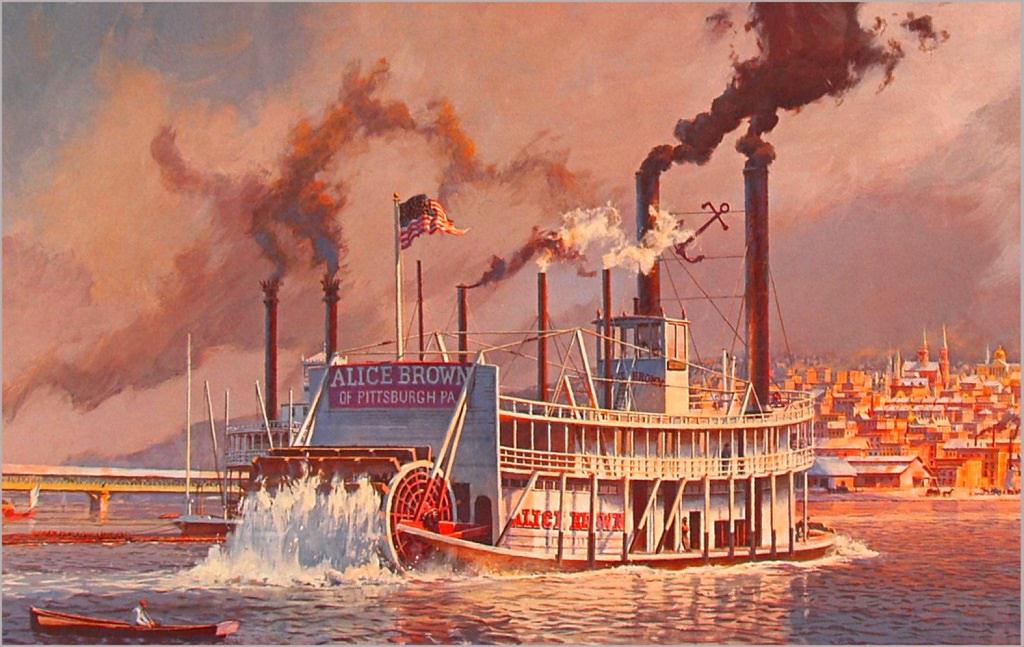
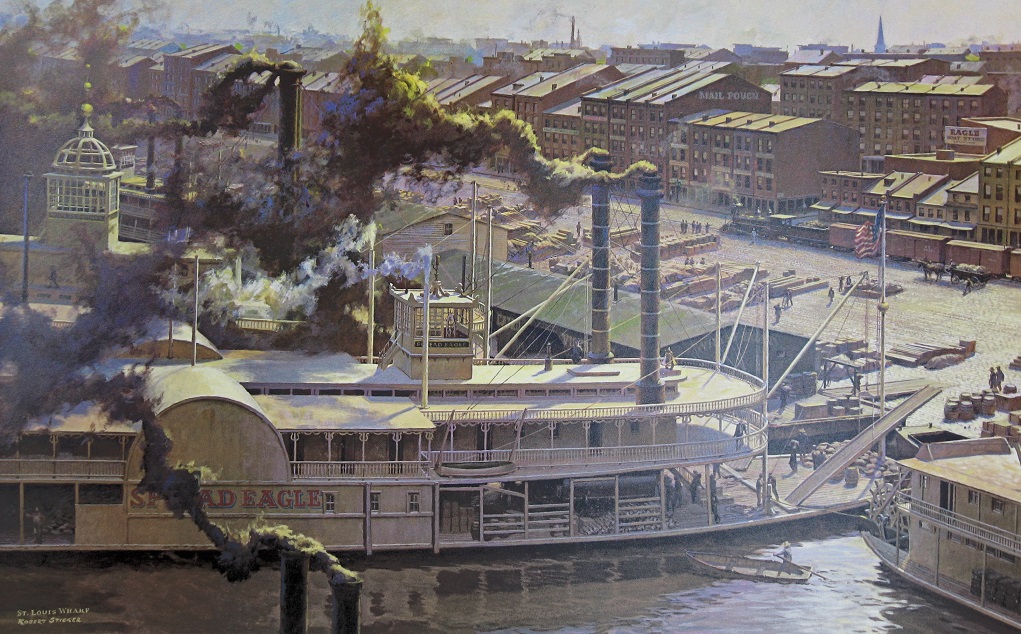
Detail of the lower left hand corner of an 1870s Robert E. Sticker painting. A wonderful depiction of the towboat ALICE BROWN that is well worth sharing with the folks who tune in to our channel for nostalgic steamboat imagery. Also attached Bob's high angle point of view of the SPREAD EAGLE at Laclede's landing. Obituary for Bob Sticker from 2011 follows.
Obituary
Published in Scranton Times on May 23, 2011
Robert E. Sticker, 88, of Pleasant Mount, died Saturday after a brief illness. His wife of 47 years is Nina Giuliano Sticker.
A native of New York and distinguished marine artist, Bob was a legend in the field of marine art. His interest in painting was lifelong. Growing up in Staten Island, N.Y., and watching the incredible activity in New York Harbor sparked an interest in the sea that intensified over the years. When World War II was declared, Bob enlisted to serve his country and chose the Navy for his love of the sea. He was assigned to officers candidate training and appointed captain of the crew of a PBY.
Over the years, he created a body of work that is singularly compelling and dramatic, and reflects the honor, respect and integrity with which he lived his life. He is widely recognized for the accuracy of his research and his unique ability to depict the drama of the human aspect of life at sea, with great compassion and poignancy, and has quietly amassed a national following for his unique and beautiful paintings.
Bob was a founding member of the American Society of Marine Artists and was also the recipient of awards from the Franklin Mint and Mystic Seaport. His paintings are included in Bound for Blue Waters, a book that is a definitive collection of the best American marine art of the 20th and early 21st century. His work is also included in the corporate collections of IBM, Union Carbide and AT&T and in numerous private collections
Also surviving are two beloved children: a son, Robert Edward Sticker Jr. and wife, Reiko; and a daughter, Marisa Sticker Volz and husband, Rick; and his equally beloved grandchildren, Reimi Gabrielle Sticker and Ale Richard Volz.
The funeral will be Wednesday from the Lawrence A. Gabriel Funeral Home, 74 N. Main St., Carbondale, with Mass at 9:30 a.m. in St. James Church, Pleasant Mount. Interment will be in St. James Cemetery, Pleasant Mount.
Friends may call Tuesday, 4 to 8 p.m. In lieu of flowers, the family requests that memorial contributions be made to the Marian Community Hospital, 100 Lincoln Ave., Carbondale.
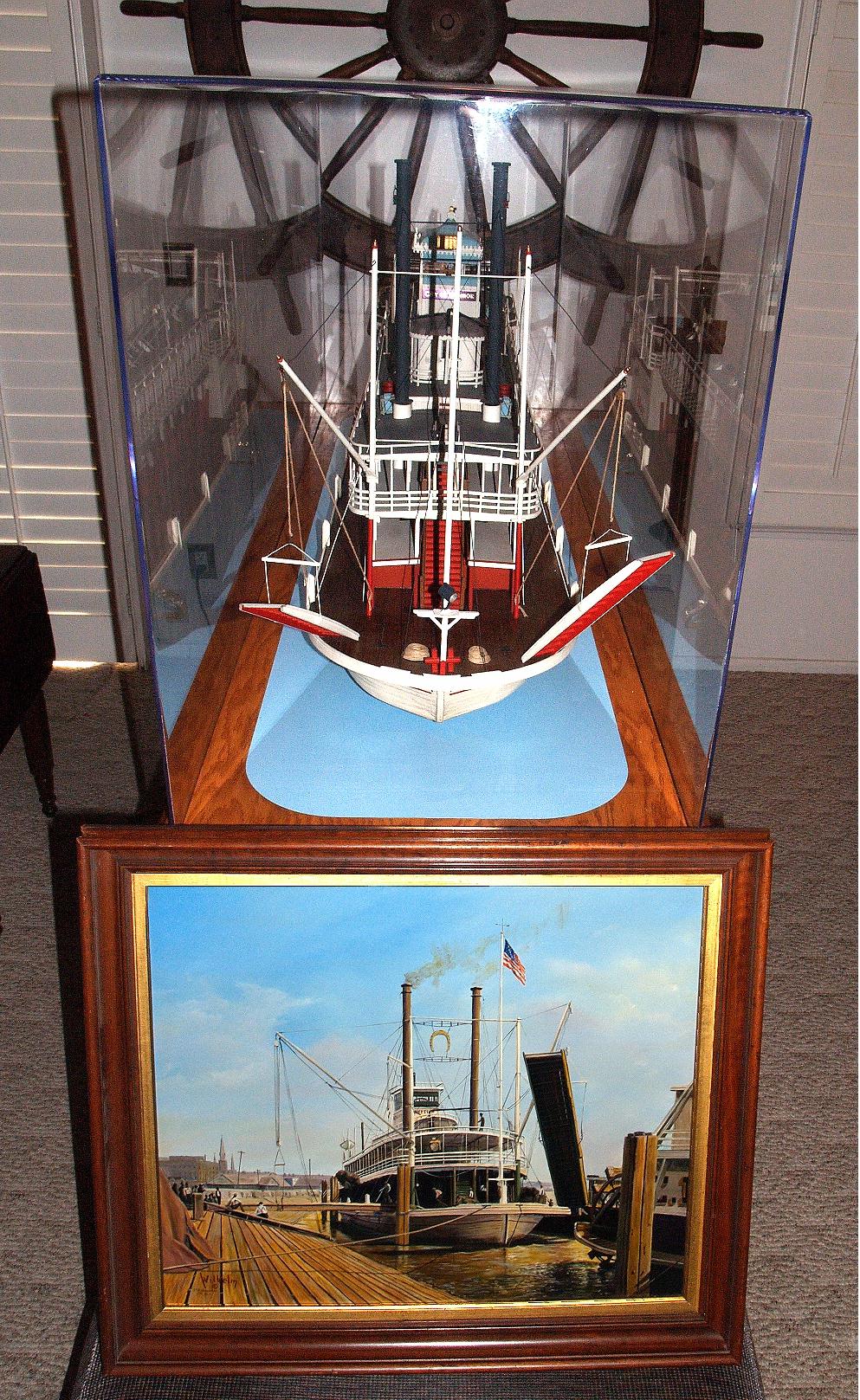
Painting of the Assumption by Wilhelm . . . in front of Jim Hale's model of the City of Monroe for comparison.
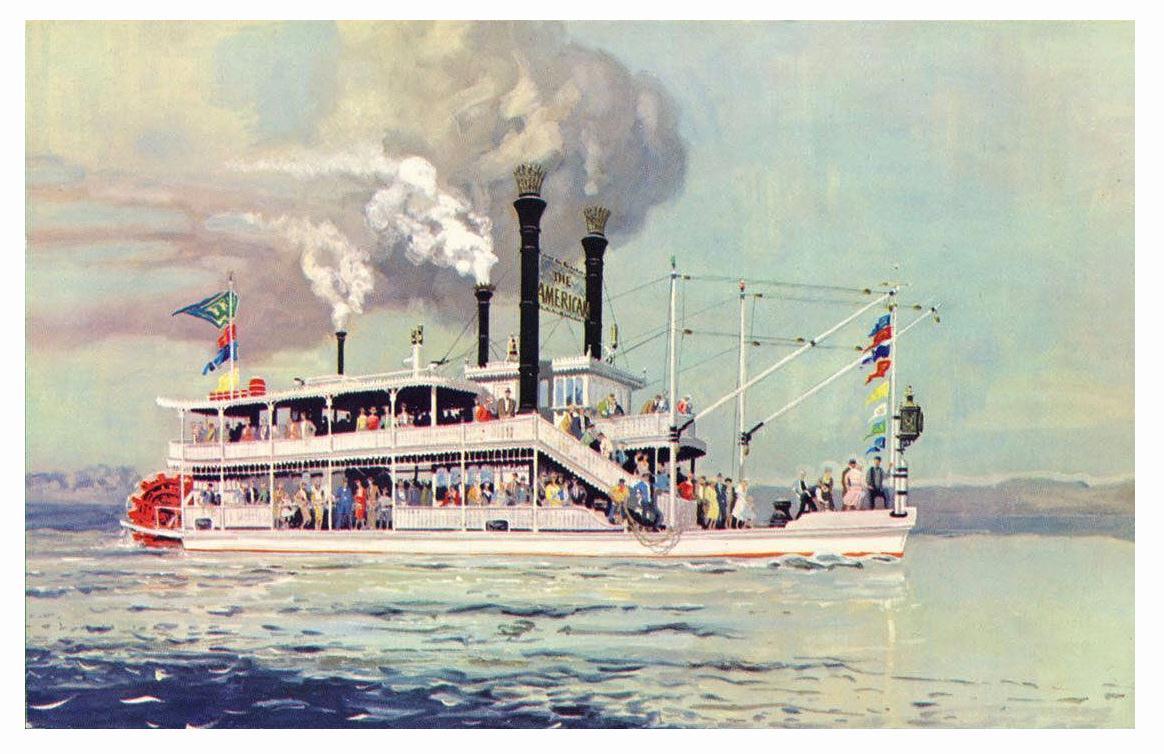
Nice artist's rendering of the 110 foot long steamboat AMERICAN on the "Great Lakes" at "Freedomland, U.S.A." - the short lived (1960-64) Bronx, New York theme park that attempted to approximate Disneyland on the East Coast. The AMERICAN also had an identical sister boat at Freedomland called the CANADIAN which for a while floated on a mill pond as part of Raymond Schmitt's "Johnsonville," a collection of historic 19th century buildings at East Haddam, Connecticut. Click here to see more photos!
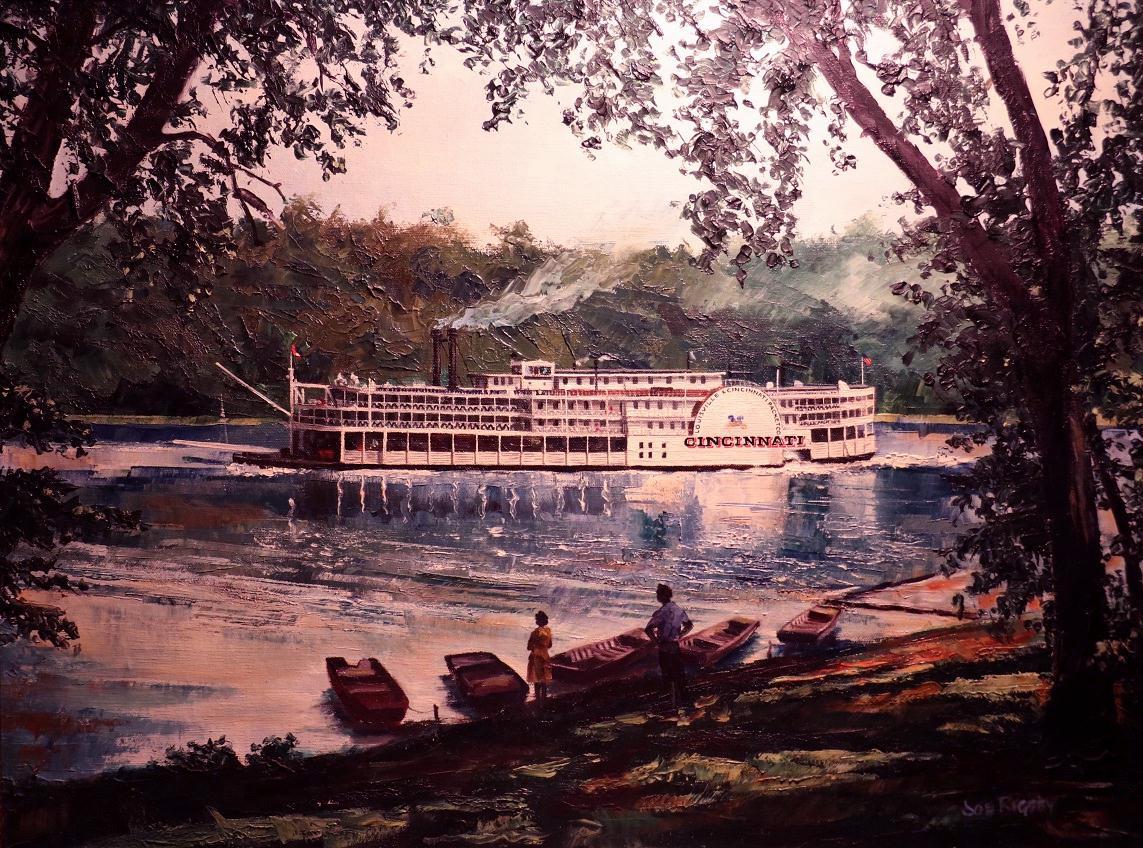
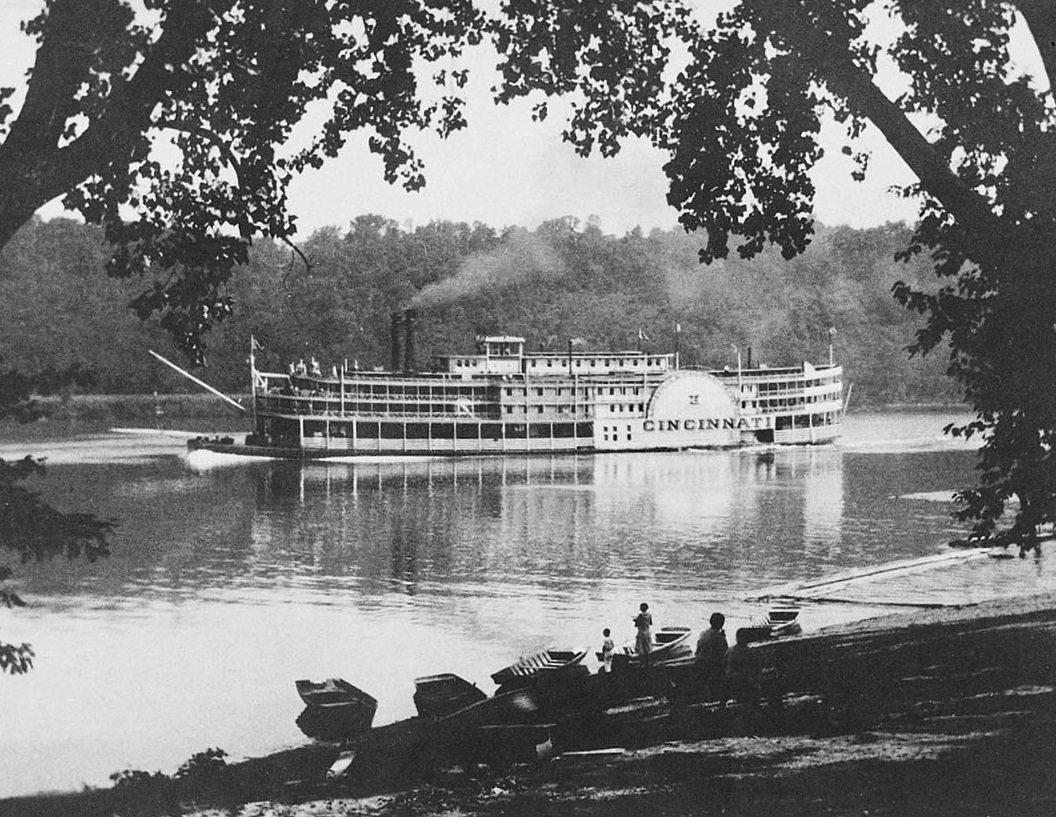
Original oil painting 18 x 24 inches by Joe Rigsby of the CINCINNATI recently obtained through a friend and art dealer in Alton, Illinois. Also included a photo of the boat from La Crosse which the artist must have based his painting on.
CINCINNATI Sidewheel Packet
Way's Packet Directory Number 1033
Hull built by Midland Barge Company, Midland, Pennsylvania and completed at Cincinnati, 1924 for John W. Hubbard of Pittsburgh;
Navigated the Ohio and Mississippi rivers
This boat had a double cabin, parlor rooms, baths, separate dining room, steam heat and all the trimmings.
She was designed by marine architect Tom Dunbar as a single-cabin packet for the Cincinnati-Louisville trade.
Before completion, the stateroom capacity was vastly enlarged by the building of a second passenger cabin.
The original cost of this boat was $417,000 of which she made back about $200,000 in the first eight years of operation.
The boat was owned by John W. Hubbard, Pittsburgh and operated by the Louisville and Cincinnati Packet Company.
She made Cincinnati-New Orleans Mardi Gras trips without a break from 1924-1930 and cleared $40,000 on her first Mardi Gras trip.
She was in Pittsburgh on several occasions, and brought the 31st annual convention of the Ohio Valley Improvement Association there in October, 1925.
She appeared for the 1929 celebration of the completion of the Ohio River locks and dams.
Her principal business was regular summer operation in the Louisville-Cincinnati packet trade.
On May 24, 1928 while between Carrollton and Madison, she collided with the MV BELMONT and engineer Homer Johnston was killed.
Hard times came with the Louisville and Cincinnati Packet Company having financial troubles.
The Cincinnati was sold to Streckfus Steamers, Incorporated, St. Louis IN 1932.
Streckfus tore her down to the hull and built a superstructure for an excursion boat named PRESIDENT.
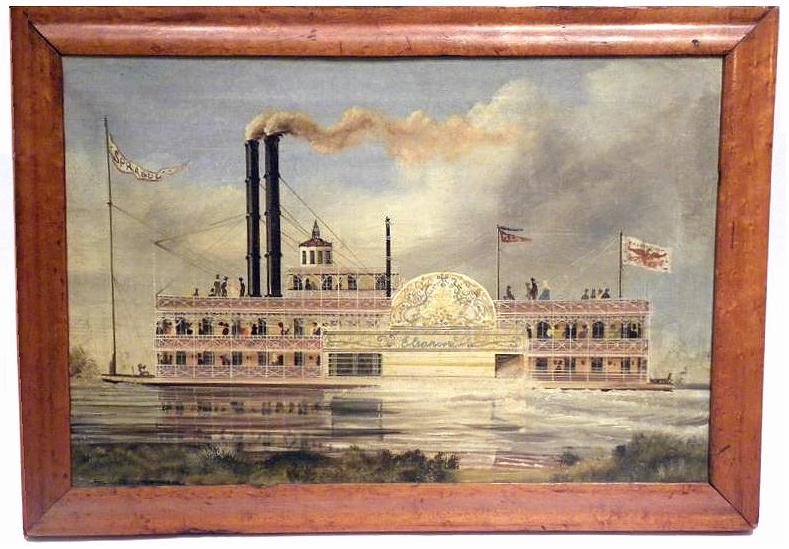
This folk art style painting was made with a lot of precision. It looks a bit fanciful as if it was dreamed up by the artist rather than an actual boat. The pennant on the flagstaff says SPRAGUE but on the paddlebox is the name ELEANORA.
The flag at the stern looks features a spread eagle in the style of a Union army battle flag during the Civil War.
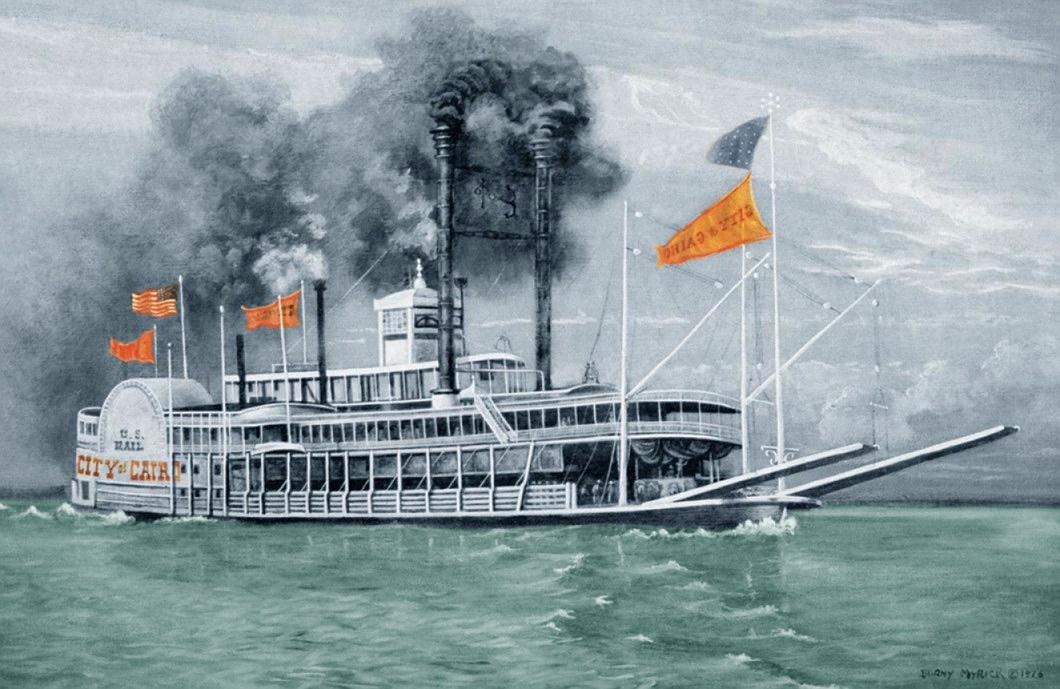
Burny Myrick's 1976 painting of the CITY of CAIRO from his art book TIMELESS RIVER. The painting had a predominantly yellow ochre cast to it which I cooled off by giving a blue cast to the sky and the steamboat then a blue green cast to the water while retaining the original orange cast to the flags and the lettering on the paddle box. The Timeless River: A Portrait of Life on the Mississippi, 1850-1900
by Burny Myrick
Oxmoor House, Inc.
Birmingham, Alabama, 1981
CITY or CAIRO 1882-1896
Way's Packet Directory Number 1056;
Built in 1882 at Jeffersonville, Indiana by Howard Ship Yards for the Anchor Line.
Home port or owner's residence circa 1882, St. Louis, Missouri.
Original price $75,350. Hegewald and Company built her engines. Usually ran St. Louis-Vicksburg.
Had the roof bell from the EMMA C. ELLIOTT, awarded by the line to the boat making the fastest run.
She gave up the bell to the CITY OF MONROE shortly before she was wrecked in a severe tornado at St. Louis on May 27, 1896. Value at the time of her loss, $40,000
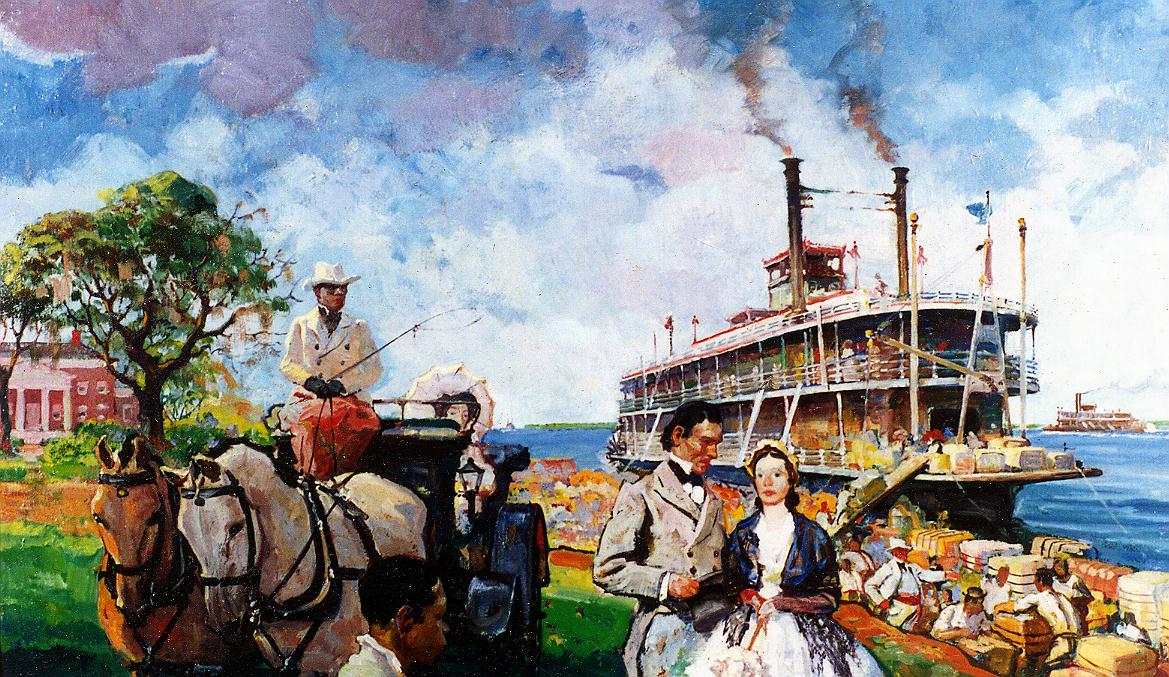
In the early '90's I bought this large painted illustration (by an artist whose name I can't recall), from a dealer in New York City who shipped it to the warehouse of the animation studio I was working for.
The dealer packed it in a cardboard box instead of in a wooden crate and I suspected that someone in the warehouse out here deliberately put a big hole through the box which penetrated the canvas, damaging it significantly. The dealer offered to have the painting repaired but I opted to send it back for a full refund instead.
The A-frame brace from which the swinging stage is suspended in the front of the steamboat looks anachronistic to the era in which the white folks on the Lower Mississippi cotton plantation are dressed in antebellum costumes. The style of the painting may have been influenced by Dean Cornwell but this picture has the appearance of a relatively quickly done oil sketch while Cornwell's illustrations are usually much more finished. See our Dean Cornwell collection, click here.
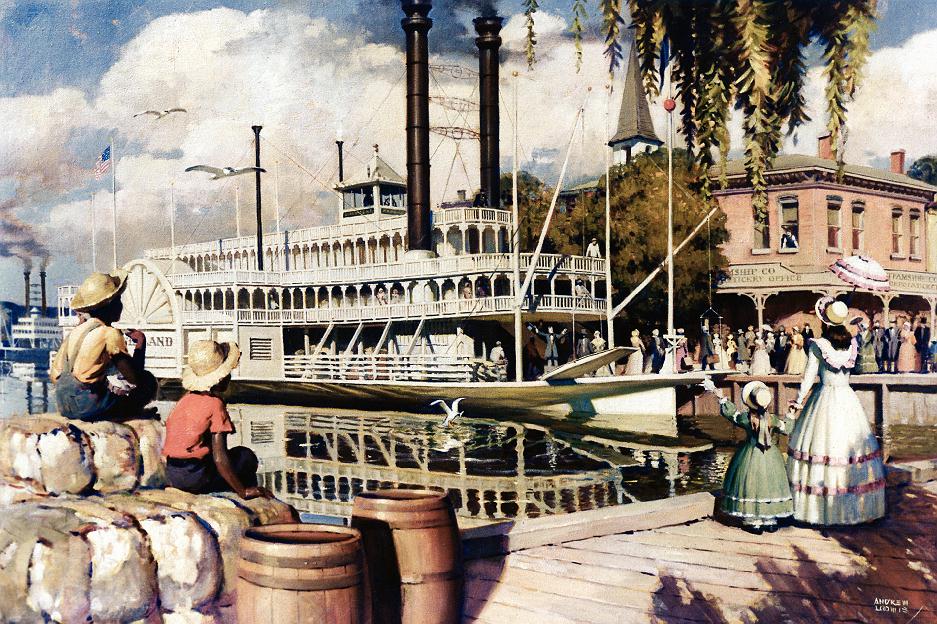
Back in the mid 1990's I bought this nostalgic steamboat painting by popular American illustrator Andrew Loomis (1892-1959) from an antique store in Montrose.
It was a huge canvas, about four feet wide and apparently painted by Loomis during his later years (he died in 1959 at age 67) on commission from a publisher who then made a run of prints from the painting at about two thirds the size of the original.
I have a bunch of copies of those steamboat prints and one made from a painting Loomis produced at the same time of a stagecoach arriving on a wild and wooly Western street where it was welcomed by a cowboy wearing chaps, some "dance hall girls" in upstairs windows and other exuberant townsfolk.
The antique dealer who sold me this told me that the nurse who took care of the fellow who had commissioned Loomis to paint this (so he could have prints made from it) gave the painting to the nurse who took care of him during a long illness. The nurse kept the canvas rolled up under her bed for something over 30 years before it resurfaced and the dealer had the canvas remounted on stretcher bars.
While I liked this painting for its brilliant use of color, draughtsmanship and brush work I felt it was a bit cloying and more of a fanciful nostalgic representation of steamboat days than a true-to-life one.
Loomis was born in Syracuse NY in 1892, but raised on the Muskingum River at Zanesville where he would have seen plenty of steamboats that came up through the locks from Marietta at the mouth of the Ohio River about 100 miles southeast of Zanesville.
But Loomis did not seem to use much if any of his eyewitness experience of river commerce at turn-of-the-century Zanesville in this painting. The steamboat appears to have been based on the "Gary Wayne," a steamboat in a nostalgic piece of early 1950's calendar art by Paul Detlefsen called RIVERBOAT DAYS.
The building next to the wharf in the painting by Loomis has signage which says STEAMSHIP CO. - DEPOT & TICKET OFFICE. Since when would a steamBOAT line on one of the Inland Waterways ever have called itself a steamSHIP company?
Some years after buying this painting I put it on consignment with Illustration House in NY City who sold it in an auction and got a good return on my investment.
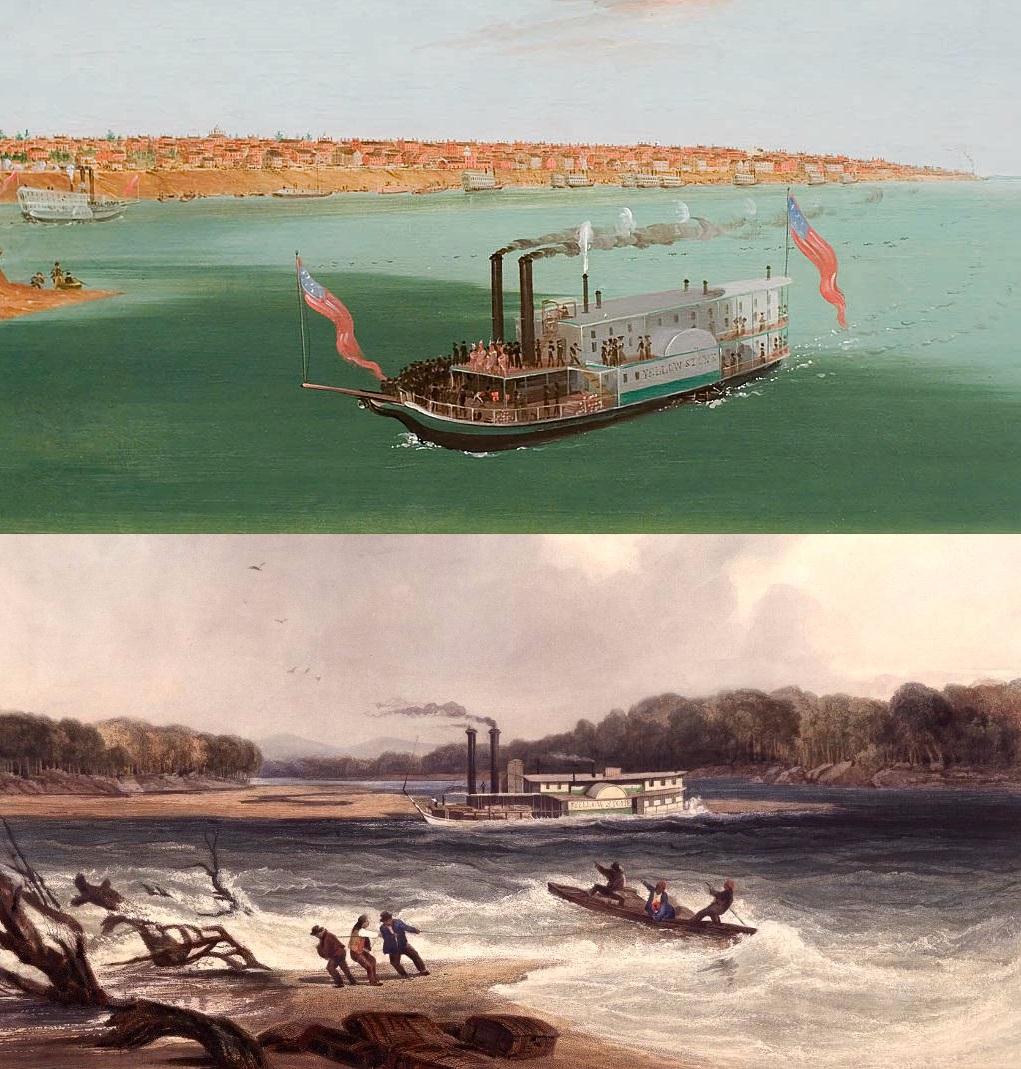
Steamboat YELLOW STONE in the early 1830's on the Mississippi and Missouri Rivers
On November 24, 1830, the American Fur Company placed an order with two firms in Louisville, Kentucky for construction of the YELLOW STONE.
$4,000 was contracted for construction of the ship, and $4,950 for building the steam engine. She was a sidewheel steamboat, weighing 144 tons, and measuring 130 feet long, by 19 feet wide and drafting 5 and a half feet.
Top painting: YELLOW STONE created in 1833 on the Mississippi River by George Catlin depicting her departure from St. Louis upstream northeast on the Mississippi River in May of 1832 on her way to the mouth of the Missouri River which she traversed upstream northwest to Council Bluffs. George Catlin, 1796-1872, American artist
More history of the YELLOW STONE's involvement in the fur trade can be found in the website Mountain Men and Life in the Rocky Mountain West and in the book Voyages of the Steamboat Yellow Stone by Donald Jackson, published by Ticknor & Fields, New York 1985.
Bottom painting: The Steamer YELLOW STONE on April 19, 1833 stuck on a sand bar. Quotation from Prince Maximillian's book "Travels in the Interior of North America, 1832-34" which was illustrated with aquatint engravings by Bodmer:
"On the morning of the 19th a flat boat was procured, to lighten our vessel, by landing a part of the cargo, which was piled up in the wood, on the bank, and covered with cloths. Mr. Bodmer made a faithful sketch of this scene."
Bodmer also painted the YELLOW STONE as seen in the distance on the Missouri River with menacing snags in the foreground (not included on this page).
Karl Bodmer 1809 - 1893, Swiss-French artist
The YELLOW STONE's adventures continued in 1835 - 36 as she supported Sam Houston's battle to win Texas from Mexico.
Riverboat Dave's account of that saga can be found at this link: riverboatdaves.com
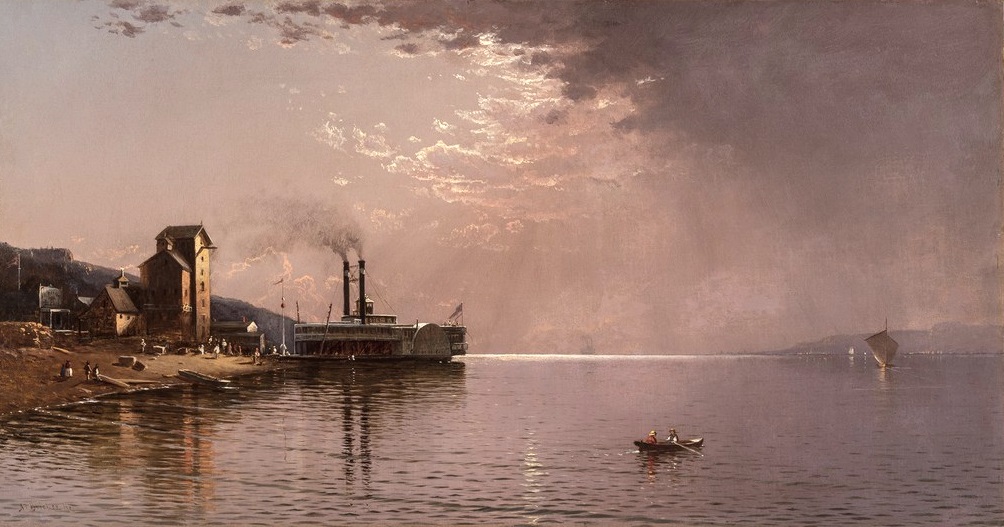
Steamer CITY OF ST. PAUL Dubuque, Iowa by artist Alfred Thompson Bricher 1872
The sidewheeler CITY OF ST. PAUL seen at Dubuque, Iowa on the Mississippi River in 1866 by artist Alfred Thompson Bricher who painted this panorama in 1872.
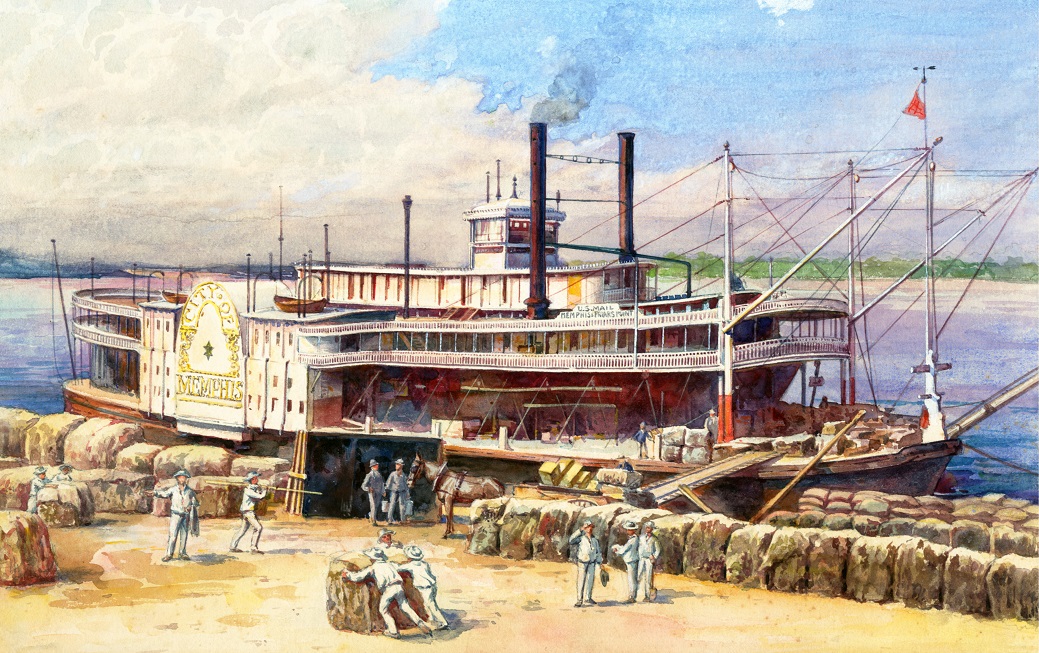
CITY OF MEMPHIS very cool original watercolor!
Fine early 20th century watercolor illustration of the riverboat CITY OF MEMPHIS.
Painting to board edge measures 8.85 inches X 13.30 inches
Blackie and Son. Original watercolor illustration.
One of a number of original illustrations used in publications by Blackie and Son of Glasgow, Scotland.
Artists included Friedrich Specht, Cyrus Cunoe, Raymond Sheppard, Jenny Wylie and others.
Unsigned and unattributed, but with investigation the picture and the artist can probably be located in one of Blackie's publications.
Purchased from Nick Winter of Gallerybs3 in Windmill Hill, Bristol - United Kingdom
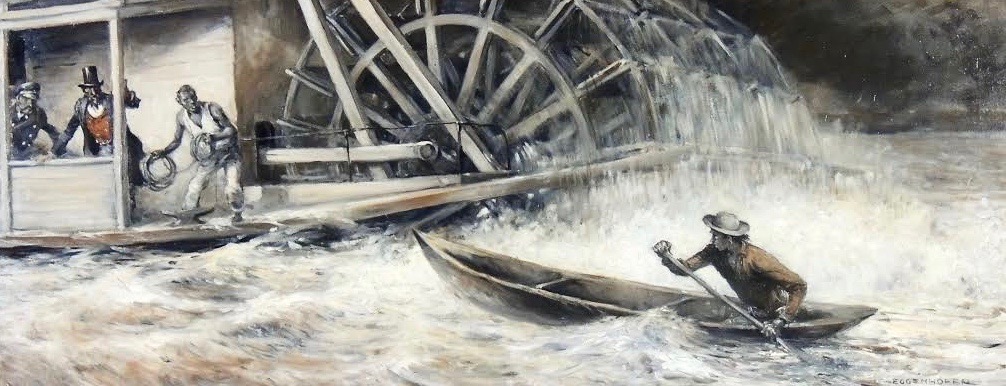
Painting "Caught in the Undercurrent of the Paddlewheel of a Steamboat"
Listed by The Illustrated Gallery where interested parties can inquire about the price.
"Caught in the Undercurrent of the Paddlewheel of a Steamboat"
By Nick Eggenhofer (American, 1897-1985)
17.00" x 40.00"
Oil on Canvas
Signed Lower Right, "Eggenhofer"
Lot no. 3536
illustratedgallery.com
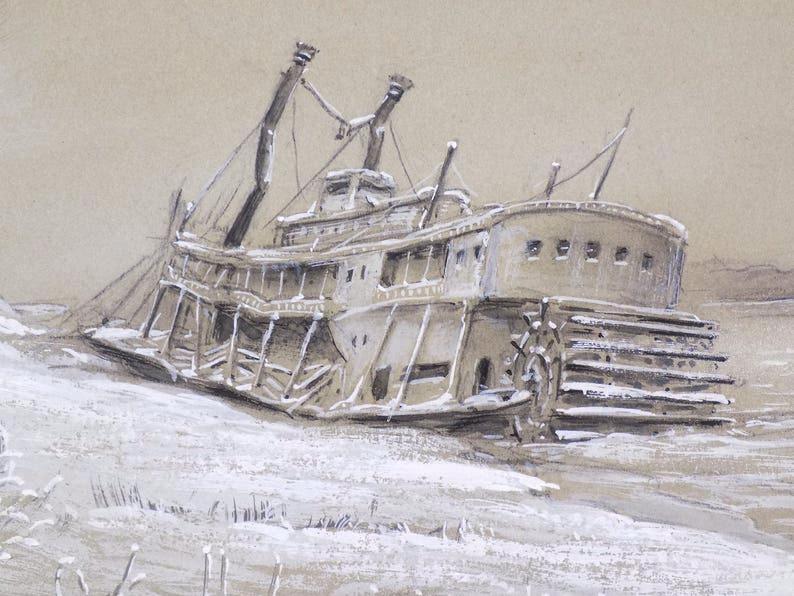
Vintage Watercolor, "Mississippi River 1944", David Hal Morris Sr.
DETAIL OF MATTED AND FRAMED PAINTING THAT IS CURRENTLY LISTED ON ETSY (27 OCTOBER, 2019)
Vintage Watercolor, "Mississippi River 1944", David Hal Morris Sr. Framed Winter Scene With Paddlewheel Boat // Illinois Artist $90.00
etsy
Free shipping to United States
Vintage from the 1940s
This handsome framed watercolor of an old paddlewheeler aground in the Mississippi River was painted in 1944 by David Hal Morris, Sr. Morris, who signed his artworks "Hal Morris, Sr."
He is a noted painter of early steamboat river history and was featured in 'Who's Who' in the 1920's. He was a newspaper artist and graphic designer, retiring from his job at the Chicago Sun Times Newspaper at the age of 92. His wife, Eva, was also a noted artist. Hal Morris's son, David Hal Morris, Jr. was also a painter; he lived in Colorado, signing his works "David Hal Morris" (no Jr.).
The frosty scene, done in grey, taupe and white, depicts one of the many paddlewheel boats that cruised the Mississippi River, run aground and obviously abandoned, the worse for wear.
It was the kind of scene Hal Morris loved to paint and he did it so well. This painting was accompanied by a receipt showing its sale in 1993 by a Crete, Illinois, antiques shop, at that time it sold for $47.93
(We'll enclose this receipt with the painting.) Presumably it was sold unframed, which is how it came to us. The cream colored matte is pencil signed bottom right: ' __Hal Morris, Sr._ ' and titled: 'Mississippi River _ 1944_' bottom left. There is also a preliminary sketch he made on the back (see photos #6 and #7). We photographed it before we had the painting framed under glass in a 1 inch wide stepped wood frame with a speckled pale gilt finish.
We naturally retained the original signed mat and our framer installed on the back a coated hanging wire complete with hanging hardware.
The framed size is 10 inches by 12 inches, with the sight size 5 1/2 by 7 1/2 inches and weighs about 1 1/4 pounds. This artwork is in excellent condition, ready to hang and admire.
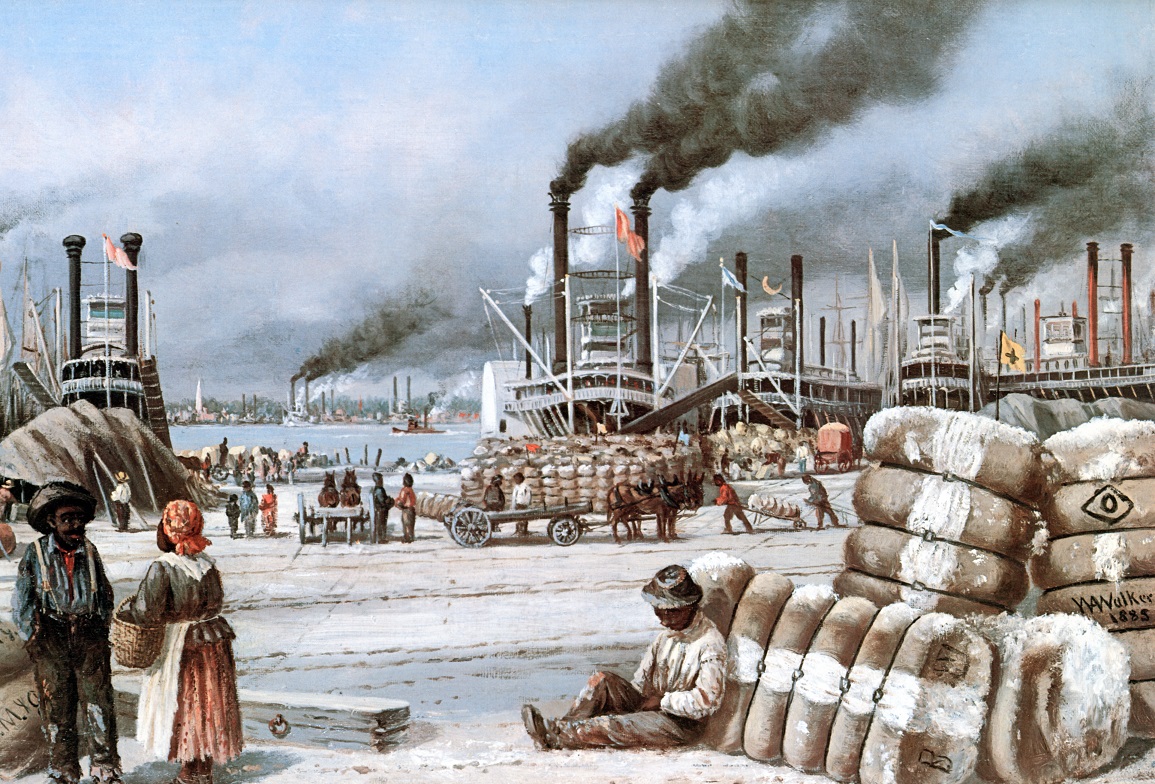
New Orleans Levee 1885 painted by William Aiken Walker
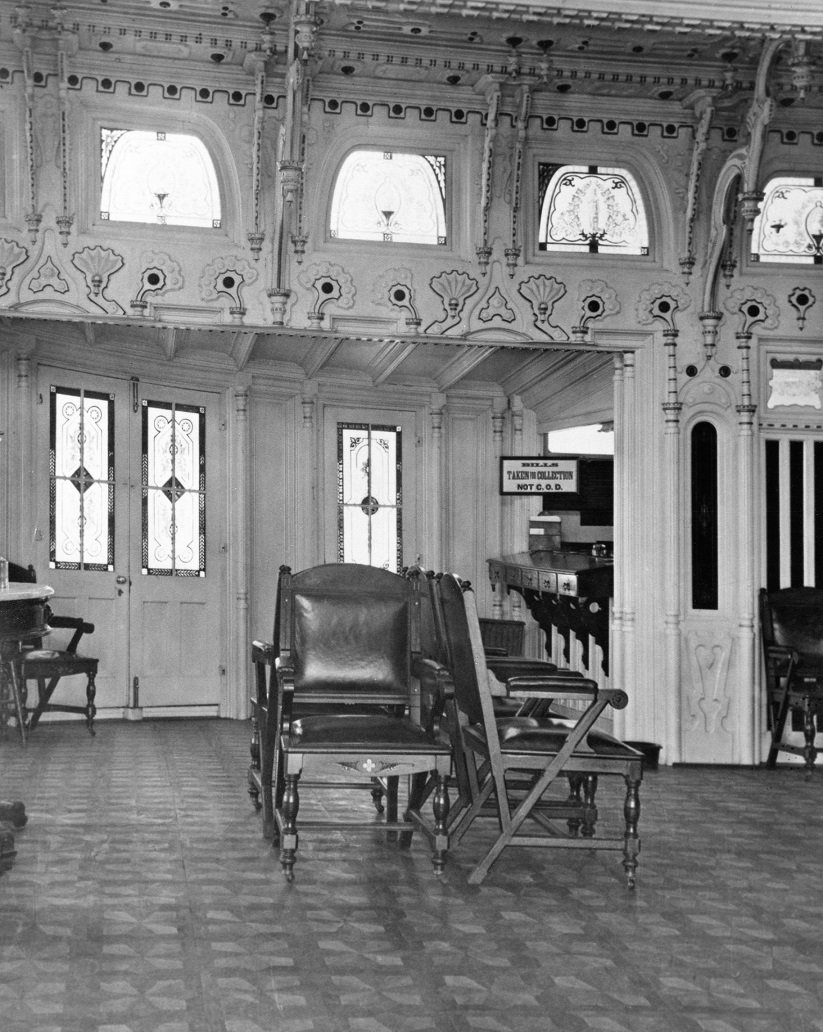
J.M. WHITE interior decor 1878 - 1886
Got this 8 x 10 print of the J.M. WHITE's cabin from an archive in Paris via eBay. I thought it might have originated from the Gandy Collection at LSU Special Collections but I couldn't locate it there.
After scanning it at a larger file I did considerable "spotting" of minor blemishes and reduced it a bit for export here. The sign over the purser's office needed the most restoration to complete the lettering. It was surprising that there were enough elements in the sign to finish the broken letters:
BILLS
TAKEN FOR COLLECTION
NOT C. O. D.
The extravagance of the interior decor was incredible, must have been at least comparable or even more ambitious than the homes of moguls on shore in ye olden days.
The J.M. WHITE, a side-wheel packet with wood hull (312.7 ft. x 47.9 ft. x 11.5 ft.), was built at Howard in 1878. Owned by Greenville & New Orleans Packet Co., the J.M. WHITE operated on the lower Mississippi River.
The 276th boat built at Howard, J.M. WHITE was the ultimate "floating palace" and the shipyard's crowning achievement. Its large main cabin (233 ft. x 19 ft. x 13ft.) was lined with rosewood and walnut burl inlaid panels and lit by seven sixteen-burner gold gilt chandeliers.
She burned at St. Maurice Plantation, Louisiana on December 13, 1886.
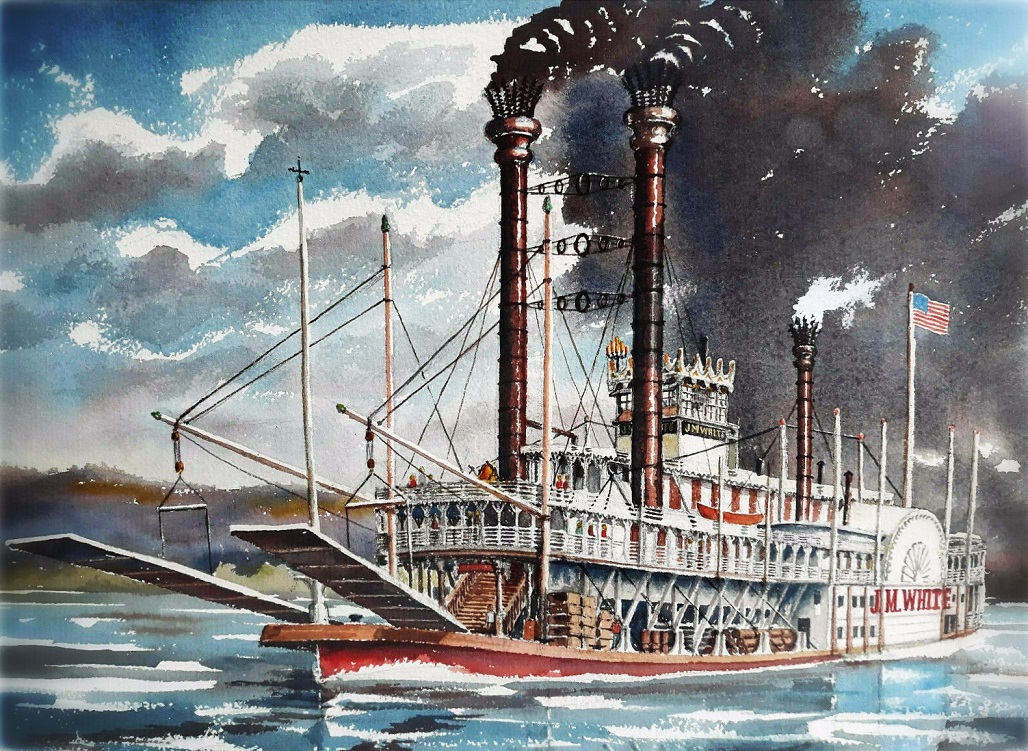
Watercolor of the J.M. WHITE painted in 1968 by Duane R. Light
Duane R. Light painted this watercolor of the steamboat J.M. WHITE in 1968.
The artist was raised in Hampton, Illinois on the Mississippi River and one of his grandfathers was a Mississippi River Steamboat Captain. The painting of the J.M. WHITE is probably the steamboat artwork mention in Duane Light's 2008 obituary. Light wrote a book on the art of watercolor, copies of which are available through amazon.
Renowned watercolor artist Duane Light, 84, dies
By BRIAN PORTER/Managing Editor
Mesquite News
Feb 13, 2008
Duane Light, the man who created watercolor landscape and still-life scenes which are being remembered as some of the finest ever in his medium, died Monday. He was 84.
Light was raised in a railroad family in Hampton, Ill., along the Mississippi River. As a young boy, he exhibited great promise as an artist.
It was then that a life-long love for trains and boats began. His father worked for the Rock Island Railroad Line and his grandfather was a Mississippi River Steamboat Captain. Among his works are pictures depicting both the Rock Island Railroad Line and a Mississippi River steamboat.
His works were rediscovered during retirement in Mesquite when a little more than five years ago he moved to Christian Care Centers.
Tommy Long, a Mesquite police officer, was called to his apartment and noted a collection of artwork which he believed needed to be shared.
"That's how we were introduced to Duane Light," said Mike Templeton, director of the Mesquite Arts Center.
"He was obviously an accomplished artist. It is the light he captured in watercolor which is the most difficult to achieve in 2-dimensional work. He was extremely talented."
Templeton was so impressed with the work, he devoted a month-long showing in May of 2007 to the work of Light at the Arts Center.
"The exhibit was extraordinarily successful," he said. The artist and the man were interconnected, explained his son, Don. "I think they are inseparable," Don said. "He was an artist and that was his whole life."
His talents were blossoming and to advance his natural abilities Light studied at Augustana College in Rock Island, Ill., The New York Institute of Photography, Irving Shapiro's American Academy of Art in Chicago, and the University of California art school at La Jolla, Calif. He worked as a Military Illustrator at the Rock Island Arsenal before and after serving in World War II.
He, then, became the art director of an advertising agency. Later, he decided to become a freelance artist and illustrator. For 21 years, as owner and operator of a large design and advertising studio, Duane taught, as well as involved himself in, drawing, painting, photography and airbrush.
While still in the Midwest, Light was elected president of the Quad Cities Art Directors Club, member of The Art Directors' Club of Chicago, president of The Illinois Professional Photographer Organization and member of Professional Photographers of America.
He established his own watercolor art studio and gallery in California called "Studio West." He was shortly thereafter named official "West Coast Demonstrator" for Grumbacher Inc., of New York.
He served as president of Watercolor West, a prestigious, by invitation only, art society, and The San Diego Watercolor Society. He served as president and was on the board of directors for The La Jolla Art Association, and served on the board of directors of The San Diego Art Institute. Light was a member and vice-president of the Rancho Bernardo Art Association in San Diego.
He was a member of Big Canadian Artists and was appointed as "Official U.S. Coast Guard Artist" in 1985.
A lifelong endeavor for the artist was teaching watercolor technique in private, group and college level settings. Light studied and painted with some of the industry's top watercolor artists, like Robert Wood and Rex Brant.
"Seeing is the miracle by which we become acquainted with the infinite beauty that surrounds us," Light said. "Learning to see; to look; to appreciate this world of vision is the basis and reason for art."
He also published five instructional books titled "Watercolor", "On the Painting of Boats", "Felt Pen and Watercolor", "Drawing the Basics" and "Mixed Media".
His travels throughout the United States and Canada were often aimed at discovering new scenes which he later put into watercolor, but he also taught workshops and offered demonstrations.
Light's art has won many honors and is an integral part of many prestigious, private, and corporate collections all over the United States and abroad. His art has been exhibited nationally in numerous galleries and one-man shows.
Perhaps his work would have been forgotten—and never realized here in Mesquite n had he not moved to the city and developed new friendships.
"He had not painted in years before he moved here," said Estelle Schiebel, who shared a love for painting with Light. "He began to teach and do demos for us. It was my pleasure to be with him to learn more about fine art than I knew before. He was an inspiration to a lot of people."
View the exclusive line of prints, watercolor art instruction books he has written and illustrated, and a collection of stationery, imprinted with some of his favorite works at www.DuaneRLight.com.
The Mesquite Arts Center also has works by Duane Light available by visiting MesquiteArtsCenter.org and clicking on artists galleries.
Watercolor - 1984 by Duane R. Light
amazon
W. Foster Art Books (1984) ASIN: B007FC825G
A "must have" for watercolor beginners as well as experienced painters.
Helpful tips regarding artists' tools, use of color and techniques. The paintings range from uncomplicated to more complex and challenging.
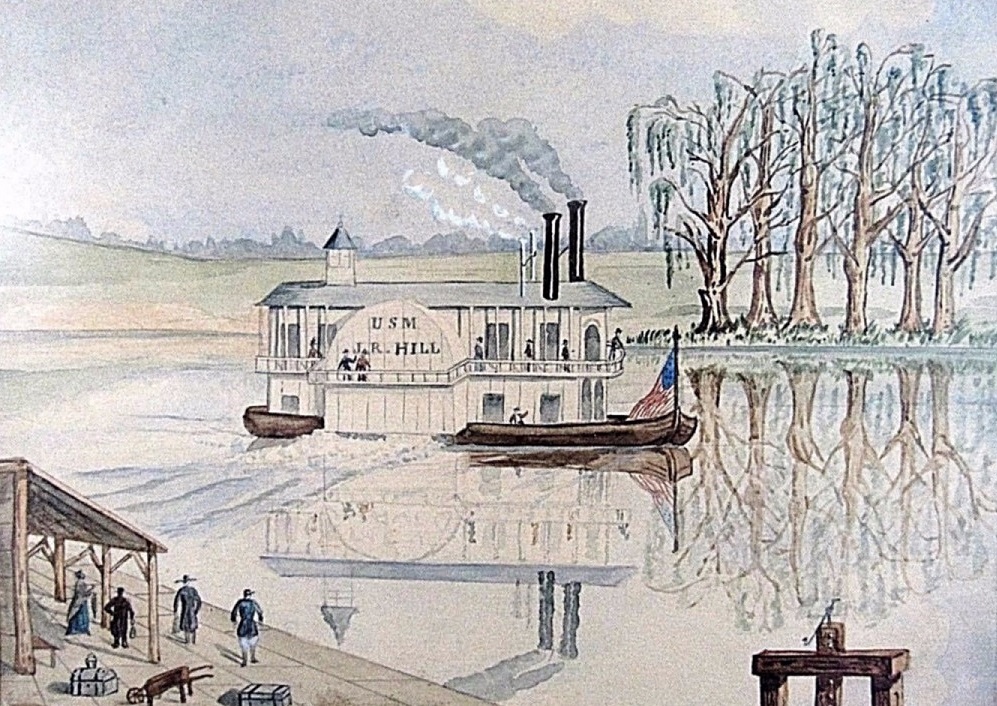
eBay listing of an 1850 watercolor of Steamer J.R. HILL
Unusual watercolor painted in 1850 of a steamboat without a pilot house. Suppose the boat could have possibly been steered from that small-windowed structure with a conical roof at the stern on the top deck; or the pilot may have steered the boat from just inside the front of the cabin on the boiler deck. A relatively small boat, this may have run on bayous in Louisiana. Fred Way doesn't have a listing for a boat with this name in his Packet Directory.
Listed on eBay: Southern Watercolor of Paddlewheeler Merchant or Mail Carrier Ca 1850. Unsigned Auction ends on Feb 12, 2019, 1:26PM Listed at $1,779.0 or Best Offer
Ebay
Artist: Sydney St. Clair Augustin Mulholland
Listed by:
RELICS ESTATE SALES & CONSIGNMENTS
Antiques|Furniture|Art|Jewelry|Collectibles
53 Persimmon Street #103
Bluffton, South Carolina 29910
We are pleased to present an American School watercolor and ink on paper 7 3/4" x 10-1/4" circa 1850 of a paddle-wheel steam-boat "USM, J. R. Hill." (USM maybe an acronym for U. S. Mail/Merchant).
Overall dimensions are 19 7/8" x 17-3/4". Suspicions arise that the subject matter is probably Southern based on the types of trees which are predominant in the painting. The background suggests some rolling hills and elevations are present. The painting is free floating and housed in a hand wrapped linen mat with non-glare museum glass. It appears relatively free of foxing with an assessment of very good condition. The frame is antique and dates slightly earlier then watercolor. They are a nice-appropriate fit. Christy's appraisal in 2001 was for estate purposes with a value of $2,000.
This is previously owned, from an estate and may have evidence of age-appropriate use. To the best of our knowledge, there are no significant flaws and we consider the pictures part of our description. 365-3921 (12-6-18)
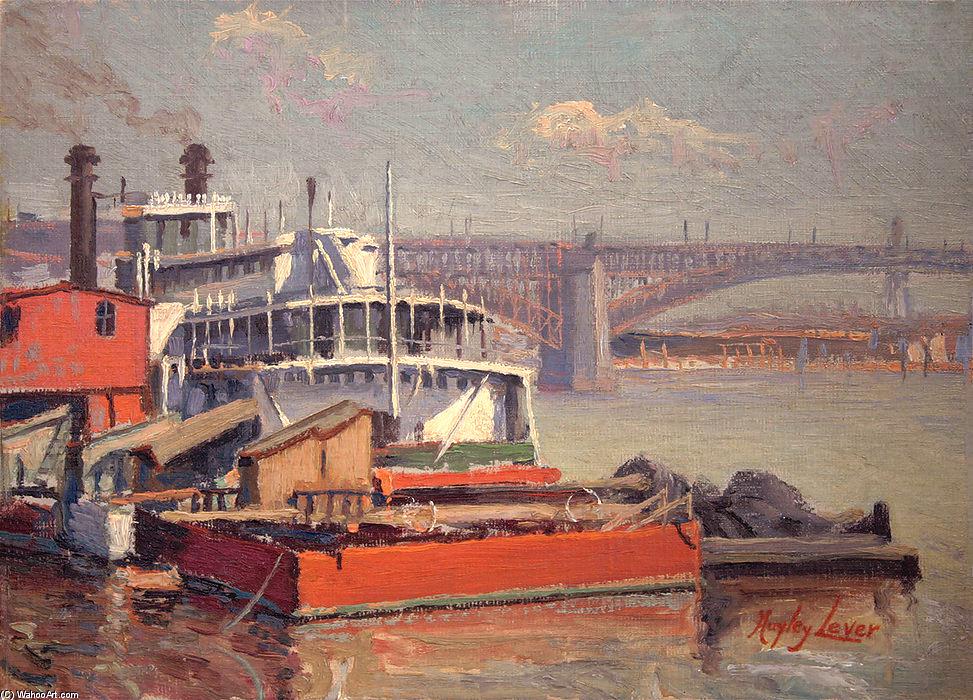
Paddle Steamer Mark Twain by Richard Hayley Lever "Art is nothing but having a good time."
Here is a wonderful painting by Hayley Lever just discovered on wahooart.com during a Google search . . . Lever loved maritime subjects and painted boats and ships in seaports and rivers in many locales here and abroad.
Richard Hayley Lever (Born in Bowden Australia in 1875 - Died in New York City in 1958)
"Paddle Steamer Mark Twain on the Mississippi River with Eads Bridge at St. Louis, Missouri" Copyright WahooArt.com
pt.wahooart.com
Hayley Lever
excerpted from wikipedia article
Wikipedia
In 1911, Ernest Lawson, an Impressionist painter, persuaded Hayley Lever to move to United States, saying he would have greater success there. Lever arrived in New York City in 1912 and painted views of the Hudson River, Times Square and Central Park. Upon discovering the American east coast, he painted in Gloucester, Massachusetts for several summers and at Marblehead, Massachusetts. Lawson and Lever developed spontaneous, bold painting styles, and Lever was accepted into Lawson's circle of friends: Robert Henri, William Glackens, John Sloan and George Bellows. He exhibited with this group regularly, but eventually left New York to settle in Massachusetts. From 1919 to 1931, Lever taught art classes at the Art Students League of New York where he maintained a Gloucester studio and often traveled to paint on Nantucket and Martha's Vineyard. He offered this message to his students:
"Art is the re-creation of mood in line, form and color. If I were confined to my own back yard for the rest of my life, I'd still have more pictures in my mind than I would have time to paint. Art is nothing but having a good time."
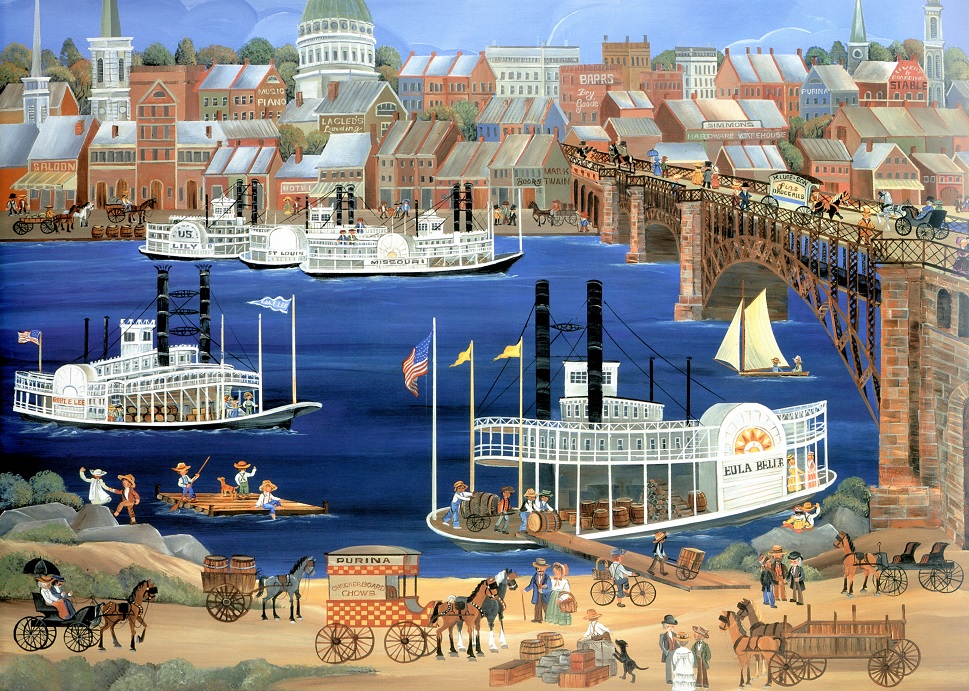
Carol Dyer's Folk Art Painting St. Louis, Mississippi River and steamboats
Detail of Carol Dyer's Folk Art painting of 19th century St. Louis, the Mississippi River and Five steamboats: LILY, ST. LOUIS, MISSOURI, ROB'T E. LEE AND EULA BELLE
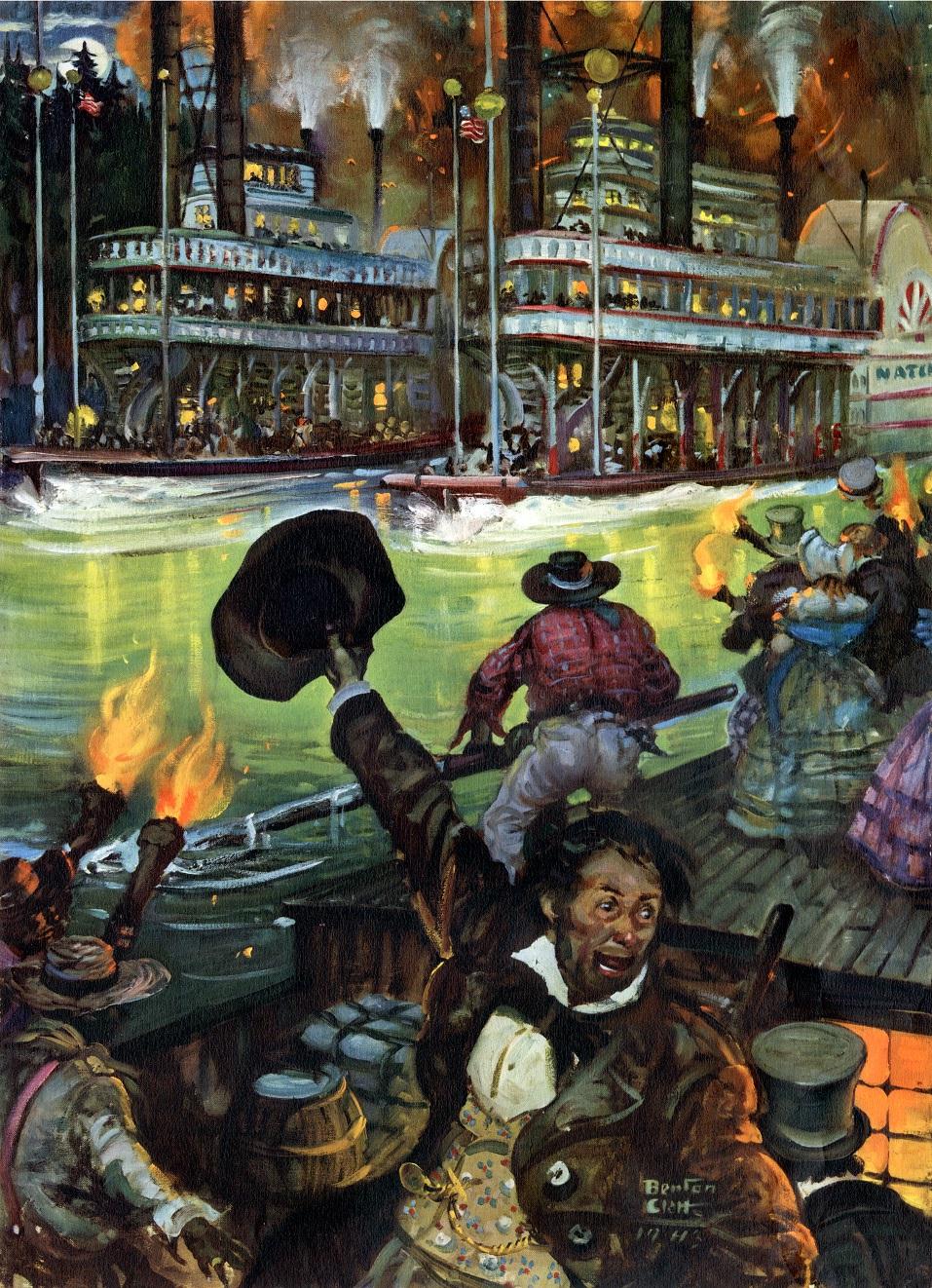
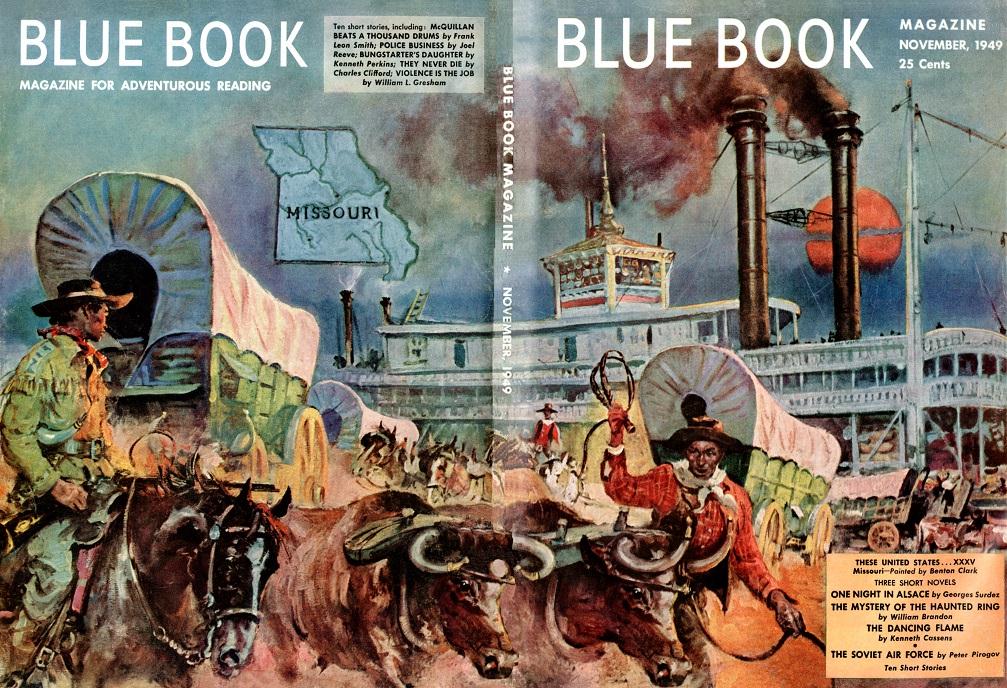
Two paintings by Benton Clark : Poster RACE OF Rob't E. LEE vs. Natchez and MISSOURI cover for BLUE BOOK 1949
FIRST:
From an 18 x 24 inch printer's proof of a 1943 painting by illustrator Benton Clark of the 1870 Race of the ROB'T E. LEE and the NATCHEZ. On board the flatboat at night in the foreground are diverse folks, several holding torches. Two African Americans lower left, a boatman at the oar at center. In the foreground are fashionably dressed plantation owners and their wives watching the race with great interest. Dude in foreground raising his hat and shouting enthusiastically. This may have been painted for a magazine illustration or as calendar art.
SECOND: Wrap around cover (front and back from BLUE BOOK Nov 49)
MISSOURI The Show-Me State
Painted by Benton Clark
These United States . . .
XXXV (35th in the cover series)
BLUE BOOK
"Magazine for Adventurous Reading"
November 1949
Two great rivers and their important role in American history put the Missouri Territory on the map early as the gateway through which migration passed westward; and they have largely contributed to the economic stability of the "Show Me State."
Between 1673 and 1723 French explorers proceeding up the Mississippi traversed the territory extensively. By 1804, when the territory of Louisiana was transferred to the United States following the Louisiana Purchase, the area, including the present State of Missouri, was well known. Lead and salt mines had been discovered.
Trade with Santa Fe from western Missouri had been attempted in defiance of Spanish authorities. In 1812, the year in which the Territory of Missouri was established, twelve St. Louisians were arrested and imprisoned for nine years for their commercial invasion of Spanish domain. However, after Mexico overthrew Spanish rule, a welcome was extended to American traders, and the Santa Fe trail became a thriving artery of trade. Its eastern terminal—first at Franklin, then at Independence, then at the present site of Kansas City, all on the Missouri River—was a clearinghouse for eastern and southern trade with the southwest. From the West, into Missouri, poured much-needed silver, and along with it, the dependable Missouri mule.
Missouri's position between the slave-holding States to the south and the free States to the north was the cause of bitter controversy in Congress when the territory petitioned for statehood in 1820. Finally, after two historic compromises, the State, with its present boundaries, was admitted to the Union in 1821.
Controversy continued to play a part in Missouri history. The Mormons, who settled in the State in 1831, were expelled eight years later. Immediately preceding the Civil War border wars with Kansas broke out. As a border State Missouri was the scene of eleven per cent of the combats of the Civil War, though few were major engagements.
Famous sons include Mark Twain, whose immortal characters Tom Sawyer and Huckleberry Finn have made famous the area around his hometown, Hannibal. Near Excelsior Springs the farm once owned by the bandit Jesse James is pointed out to visitors. Today's most famous Missourian is President Harry S. Truman, a native of Independence.
Industry and agriculture combine to make Missouri an economically sound State. Her sons can say "Show Me" with assurance. No one can show them much that Missouri does not already have.
somervillemanning.com
Benton Clark 1895 - 1964 became an eastern illustrator of the West in the dramatic tradition of Frederic Remington, and especially loved painting horses.
He also did murals in Chicago and Columbus, Ohio. Growing up in Coshocton, Ohio, he lived in a picturesque rural setting of woods and valleys near the old Ohio Canal. A group of artists were working there, and one of them, Arthur Woelfle, gave Clark his first lessons and encouraged him to seek further training.
Later, Woelfle said that of all his students, Clark was the most talented. In 1913, Clark went to New York City to study at the National Academy of Design, and then in 1915 to Chicago to study at the Art Institute.
He sold magazine cover and calendar illustrations, and in 1925, began illustration work for Liberty and Outer's Recreation magazines.
He also illustrated for The Saturday Evening Post, and had a period of working for MGM Studio's art department in Culver City, California.
Clark's major influences were Harvey Dunn, Frank Hoffman, and Frederic Remington, and in 1932 he became a member of the Society of Illustrators.
That year, he returned to New York City and did western illustrations for leading magazines such as The Saturday Evening Post, McCall's and Good Housekeeping.

With the exception of images credited to public institutions,
everything on this page is from a private collection.
Please contact Steamboats.com for permission for commercial use.*
All captions provided by Dave Thomson, Steamboats.com primary contributor and historian.
